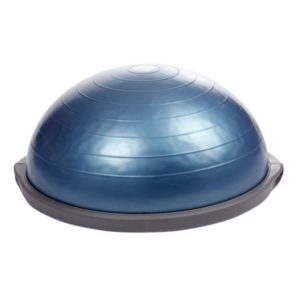by Mitch Hauschildt, MA, ATC, CSCS
Not too many years ago, instability training was the next big thing. It promised to solve all of our movement pattern issues and make mediocre athletes ready for draft day. Every was doing it or wanted to do it.
Instability training is basically using anything that one can think of to make standing or balancing more difficult. Items like stability balls, dyna discs, Airex pads, BOSU balls, half foam rolls, wobble boards and Core Boards are all examples of tools that people suggested that we use to improve stability.
We were told for a while that if we could stand on a stability ball and perform countless squats, that somehow we were athletic. Initially, I went along with it because I was young in my career and not very excited about bucking the current trend. But, I can’t deny that I never really understood why we should be doing those things because I never saw a stability ball squat competition on ESPN. Seriously, what does squatting on a ball have to do with being an athlete? The only guys that I knew that could do it were decent high school athletes who never amounted to a whole lot but had developed that skill. Meanwhile, the guys that I played college football with that ended up in the NFL couldn’t dream of squatting on a stability ball. So, who’s the better athlete?
Let’s also be honest, just because I didn’t see a competition for stability ball squats on ESPN, doesn’t mean that it is or isn’t a sport. After all, the Nathan’s national hot dog eating competition is broadcast on ESPN every year. I don’t necessarily consider that a sport, but I digress. Back to the point at hand…how does something like standing on a really unstable surface make us more athletic or function better?
I have to say that the idea of progressing people over time is one that I believe in, which is where stability training started, so I will give it a thumbs up there. Start out easy and progress to harder and more complex tasks over time. That can include increasing the demand on the nervous system in order to challenge stability and motor control. That’s where I agree with the concept.
The problem is that it is usually taken to the extreme. Things like BOSU balls are so unstable that I’m pretty sure more people get injured trying to get on them than people get injured in a sporting activity. When they get that unstable, performing exercises with these devices become a specific skill all to themselves. Their ability to transfer over to activities of daily living or sport skill becomes very poor.
Because of these and other issues with the practice of instability training, I thought that the fitness and rehab profession had pretty much moved away from it. But, today on my news feed on social media, I encountered an ad for new product that basically looked like a giant, air inflated donut that promised to have the most difficult workout ever.
Just because a workout is difficult doesn’t mean it is good. Any knucklehead coach can run someone until they puke. That doesn’t prove that they know what they’re doing. It proves that they are dumb.
 Just because something is hard, doesn’t make it a good exercise or workout.
Just because something is hard, doesn’t make it a good exercise or workout.
Please, stoping using all of the toys to prove that you can make things hard. Don’t get me wrong, they have their time and place and I have all of the toys at my disposal, but they only come out in very specific circumstances. Asking someone to perform exercises on something that is ultra unstable isn’t doing anyone any good.
Train people to their neural edge. This can be done for most people with a little bit of creativity and no equipment. It comes down to changing postural positions and center of mass. They will do a much better job of transferring those movements over to actual specific movements than any unstable implement.


Leave a Reply